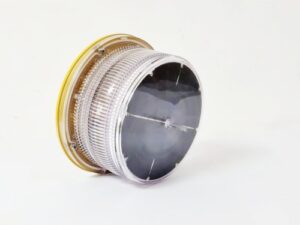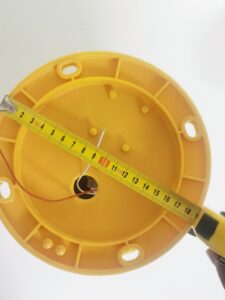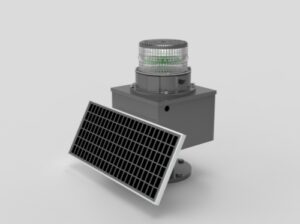The question of brightness in obstruction lights is often raised, especially by users who lean towards brighter options. However, the answer is nuanced and varies depending on the industry and international standards.
No, brighter is not universally better. The brightness of obstruction lights is regulated by international standards, which differ depending on the sector.
Let’s delve deeper into this multi-faceted topic.

Why Isn’t Brightness the Sole Factor?
While brightness is crucial for visibility, excessive brightness can result in glare, impairing the ability to judge distance and speed. Various studies support this claim.
How Do International Standards Vary by Sector?
International standards like CAAC, ICAO, and FAA provide guidelines that differ depending on the industry—be it high-rise buildings, chimneys, or wind turbines. Here’s a sector-specific breakdown:

High-Rise Buildings
- H ≤ 45m: Low-intensity lights at the top.
- 45 < H < 105m: Medium-intensity lights at the top, low-intensity at the middle level.
- H ≥ 150m: High-intensity lights at the top and intervals of 75-105m, medium-intensity lights in between.

Towers
- H ≤ 30m: 1 low-intensity light at the top.
- 30m < H ≤ 45m: 1 dual low-intensity light at the top.
- 45m < H ≤ 90m: 1 medium-intensity light at the top, 1 low-intensity light at the 1/2 level.
- 90m < H ≤ 150m: 1 medium-intensity type A light at the top, low or medium-intensity lights at 2/3 and 1/3 levels.
- H ≥ 150m: High-intensity lights at the top and intervals of 75-105m, medium-intensity lights in between.

Chimneys
- H ≤ 45m: Medium-intensity light at the top.
- 45 < H ≤ 105m: Multi-layer lights, medium-intensity at the top, low-intensity at other layers.
- H ≥ 150m: Multi-layer high-intensity lights, medium-intensity lights in between.

Wind Turbines
- H < 150m: Medium-intensity lights.
- 150m ≤ H ≤ 315m: Second light as an alternate, intermediate level with low-intensity lights.
What do ICAO and FAA say about Intensity?
Once you’ve determined the type of aviation obstruction light required for your structure, the next step is to establish or review the technical specifications. This will guide you in selecting a supplier that can meet your specific needs.
Applicable FAA Advisory Circulars:

| Type Description | Type Description |
| L-810 | Steady-burning red obstruction light L-856 High in tensity flashing white obstruction light, 40 Flashes Per Minute (FPM) |
| L-857 | High intensity flashing white obstruction light, 60 FPM |
| L-864 | Flashing red obstruction light, 20-40 FPM |
| L-865 | Medium intensity flashing white obstruction light, 40 FPM |
| L-866 | Medium intensity flashing white obstruction light, 60 FPM |
| L-885 | Flashing red obstruction light, 60 FPM |
ICAO Annex 14, chap. 6

| Light Type | Color | Signal type (flash rate) | Peak intensity (cd) at given Background Luminance | |||
| Above 500cd / m2 | 50-500cd / m2 | Below 50 cd /m2 | Vertical Beam Spread © | |||
| Low-intensity, Type A (fixedobstacle) | Red | Fixed | N/A | 10 mnm | 10 mnm | 10° |
| Low-intensity, Type B (fixedobstacle) | Red | Fixed | N/A | 32 mnm | 32 mnm | 10° |
| Low-intensity, Type C (mobileobstacle) | Yellow Blue (a) | Flashing (60-90fpm) | N/A | 40 mnm (b) 400max | 40 mnm (b)400 max | 12° (h) |
| Low-intensity, Type D Follow-me Vehicle | Yellow | Flashing (60-90fpm) | N/A | 200 mnm (b)400 max | 200 mnm (b)400 max | 12° (h) |
| Medium-intensity, Type A | White | Flashing (20-60fpm) | 20 000 (b) ± 25% | 20 000 (b) ± 25% | 2000 (b) ± 25% | 3° mnm |
| Medium-intensity, Type B | Red | Flashing (20-60fpm) | N/A | N/A | 2000 (b) ± 25% | 3° mnm |
| Medium-intensity, Type C | Red | Fixed | N/A | N/A | 2000 (b) ± 25% | 3° mnm |
| High-intensity, Type A | White | Flashing (40-60fpm) | 200 000 (b) ± 25% | 20 000 (b) ± 25% | 2000 (b) ± 25% | 3°-7° |
| High-intensity, Type B | White | Flashing (40-60fpm) | 100 000 (b) ± 25% | 20 000 (b) ± 25% | 2000 (b) ± 25% | 3°-7° |
Conclusion
Brightness is an important but not singular factor in the effectiveness of obstruction lights. Adherence to sector-specific international standards ensures that these lights fulfill their primary role—ensuring safety—without causing unintended consequences like glare or excessive energy consumption. Users should consult these standards when choosing the appropriate lights for their specific needs.





